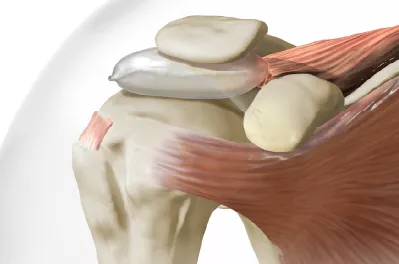UI Sports Medicine first in Iowa to offer subacromial spacer for massive rotator cuff injury
Balloon implant technology a new option in shoulder care

You may be familiar with the term “rotator cuff” from sportscasters describing a specific type of shoulder injury to a professional athlete.
In fact, it is one of the most common causes of shoulder pain and disability among all adults. Each year, approximately 2 million Americans seek medical help for rotator cuff tears, according to the American Academy of Orthopedic Surgeons.
With a rotator cuff tear, any activity that involves raising or rotating the arm can be difficult and extremely painful. Rest and physical therapy are the standard treatments, and in some cases, surgery may be necessary.
For patients with a massive rotator cuff tear, a new arthroscopic implant procedure now available from University of Iowa Sports Medicine may help reduce shoulder pain, improve function, and speed up recovery.
First in Iowa to use subacromial spacer
UI orthopedic surgeon Matthew Bollier, MD, is the first in Iowa to use the InSpace subacromial spacer, which received Food and Drug Administration approval in September 2021. It is a biodegradable balloon implant that is inserted into the shoulder above the rotator cuff and “blown up” with saline.
The spacer can be used in one of two ways: to help protect a massive rotator cuff repair or to stabilize the shoulder’s ball-and-socket joint in patients whose rotator cuff cannot be fixed.
What is a rotator cuff tear?
Your shoulder is made up of three bones: the upper arm bone (humerus), shoulder blade (scapula), and collarbone (clavicle). Your shoulder works as a ball-and-socket joint—the ball, or head, of the upper arm bone fits into a socket in the shoulder blade.
Your arm is kept in the shoulder socket by the rotator cuff, which is a group of four muscles that come together as tendons to form a covering around the ball of the upper arm bone. There is also a lubricating sac (known as a bursa) between the rotator cuff and the bone on the top of the shoulder. The bursa allows the rotator cuff tendons to move smoothly when you use your arm. With a rotator cuff injury, the bursa can become inflamed and painful.
When one or more of the rotator cuff tendons is torn, the tendon becomes partially or completely detached from the ball in the ball-and-socket joint.
Subacromial spacer helps lessen pain, speed up recovery
The subacromial space refers to the area above the shoulder’s ball-and-socket joint and below the acromion, the upper-most bone of the shoulder. The rotator cuff and bursa are in the subacromial space.
The new InSpace balloon implant restores the subacromial space and helps center the humeral head (the ball in the ball-and-socket joint), providing pain relief and improved shoulder function.
Whether it is used in conjunction with rotator cuff repair surgery or as a stand-alone treatment for patients who are not candidates for rotator cuff surgery, the minimally invasive subacromial spacer procedure can help shorten a patient’s rehab, notes Bollier, who also serves as a team physician for the Iowa Hawkeyes.
“With the balloon, we’re able to start physical therapy right away,” says Bollier, who has used the InSpace subacromial spacer in more than 40 patients since the technology was approved by the FDA. “Patients experience less pain, which helps speed up the recovery process.”

